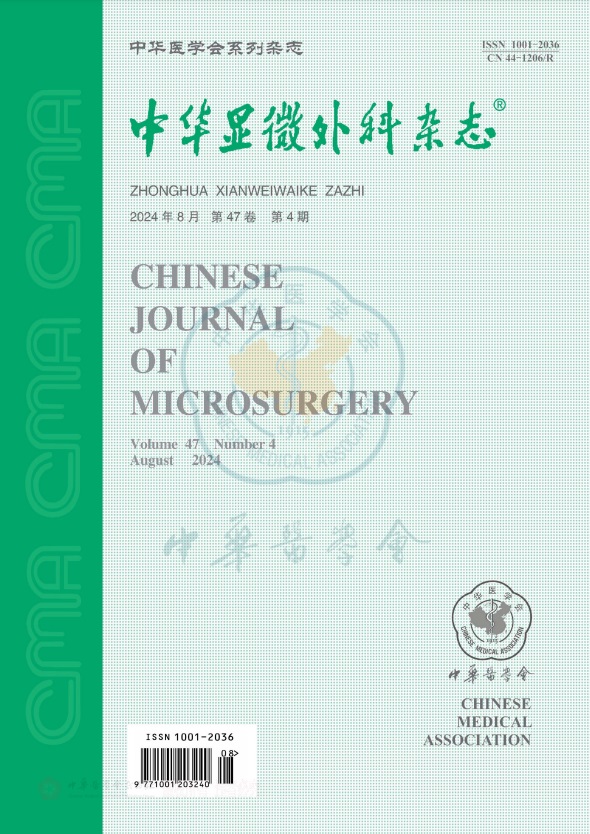以桡动脉掌浅支为蒂的血流瓣桥接手指软组织血管复合缺损
引用次数: 0
摘要
目的探讨以桡动脉掌浅支为蒂的血流瓣桥接手指软组织血管复合缺损的手术方法及临床效果。方法2013年2月~ 2018年3月,采用桡动脉掌浅支为蒂的血流瓣治疗9例断指软组织血管复合缺损。皮瓣设计于腓骨肌近端,供区直接缝合。皮瓣尺寸3.0 cm ×1.5 cm-4.0 cm×2.2 cm。皮瓣内桡动脉浅支用于桥接指动脉。手指近端和远端静脉通过皮下静脉桥接。采用正中神经掌皮移植修复掌指神经缺损。术后定期随访手指外观、感觉及关节功能。结果所有移植皮瓣均成活,随访7 ~ 33个月。供体部位得到了初步愈合,留下了笔直的疤痕。皮瓣的外观和质地令人满意。两点辨别范围从8到11毫米。皮瓣的痛觉、温觉和触觉均有明显改善。断指的外观和功能恢复良好。结论以桡动脉掌浅支为蒂的血流瓣易于采集和吻合,对供区具有遮盖性和切口小的优点。是一种理想的手指断指桥接和手指伤口修复方法。关键词:外科皮瓣;桡动脉掌浅支;主要材料;断指再植本文章由计算机程序翻译,如有差异,请以英文原文为准。
Using Flow-through flap pedicled with superficial palmar branch of radial artery for bridging finger replantation complex defect of soft tissue and vessel
Objective
To evaluate the surgical technique and clinical effect of applying Flow-through flap pedicled with superficial palmar branch of radial artery for bridging finger replantation complex defect of soft tissue and vessel.
Methods
From February, 2013 to March, 2018, 9 cases of severed fingers composited defect of soft tissue and vessel were treated with Flow-through flap pedicled with superficial palmar branch of radial artery. The flap was designed from the proximal end of rasceta and the donor sites were sutured directly. The size of flaps was 3.0 cm ×1.5 cm-4.0 cm×2.2 cm. The superficial branch of the radial artery in the flap was used to bridge the finger artery. And the vein of proximal and distal ends in the finger was bridged by the subcutaneous vein. The proper palmar digital nerve defect was bridged by palm skin graft of median nerve. The appearance, feeling and joint function of fingers was followed-up regularly after operation.
Results
All transfering flaps survived and all cases were followed-up for 7 to 33 months. The donor sites got primary healing with straight scars. The appearance and texture of the flaps were satisfactory. Two-point discrimination ranged from 8 to 11 mm. The pain sensation, warmth sensation and touch sensation of the flaps got better. And the appearance and functions of severed fingers recovered well.
Conclusion
The Flow-through flap pedicled with superficial palmar branch of radial artery is easy to harvest and anastomose, which is masked and a small incision for the donor site. It is an ideal method for bridging severed fingers and repairing of finger wound.
Key words:
Surgical flap; Superficial palmar branch of the radial artery; Flow-through; Replantation of severed digits
求助全文
通过发布文献求助,成功后即可免费获取论文全文。
去求助
来源期刊
CiteScore
0.50
自引率
0.00%
发文量
6448
期刊介绍:
Chinese Journal of Microsurgery was established in 1978, the predecessor of which is Microsurgery. Chinese Journal of Microsurgery is now indexed by WPRIM, CNKI, Wanfang Data, CSCD, etc. The impact factor of the journal is 1.731 in 2017, ranking the third among all journal of comprehensive surgery.
The journal covers clinical and basic studies in field of microsurgery. Articles with clinical interest and implications will be given preference.

 求助内容:
求助内容: 应助结果提醒方式:
应助结果提醒方式:


